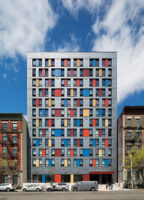Bowman Senior Residences by Poster Frost Mirto
Nogales, Arizona

Photo © Liam Frederick Photography

Photo © Liam Frederick Photography


Architects & Firms
Nogales may be Arizona’s largest border city, but factors such as its hilly topography and lack of public transportation have limited adequate housing options, especially for seniors. A long-abandoned hotel in this quaint frontier town, however, has been adapted to provide affordable apartments for residents 62 and over.
Originally built in 1917 as temporary lodging for workers passing through the border, the erstwhile Bowman Hotel’s century-old structure recalls a time when the railroad was new to Nogales, then a nascent hub of transportation and business. In 1976, the guesthouse ceased operation, and the three-story building’s top floors were left vacant for 40 years. Seeing an opportunity to revitalize the city’s sleepy downtown, the nonprofit Nogales Community Development Corporation partnered with Tucson-based firm Poster Frost Mirto and affordable housing developer Gorman & Company to give the weathered brick edifice a new life.
“The historic facade has been important to the fabric of Nogales,” says Poster Frost Mirto principal Corky Poster, “so a main priority was to salvage as much of the original building as we could.” In order to support the masonry and preserve the street front while gutting the interior, the firm expanded the building’s height and length by adding a new concrete masonry unit structure, like a Tetris piece. Using funds from low-income housing tax credits and bank loans to finance the $8 million project, the team created 48 units at 650 square feet each.
The architects brought light and air into the 50,000-square-foot facility by placing a courtyard on the ground level and carving out a four-story atrium so that residents are connected to the outside when entering and exiting apartments. To foster a sense of community, the architects included a fitness center, business center, multipurpose room, and shared kitchen.
A result of close collaboration with the community, the Bowman residences—which opened last year—exemplify how partnership and a respect for the past can resuscitate an aging landmark while adding social value.






